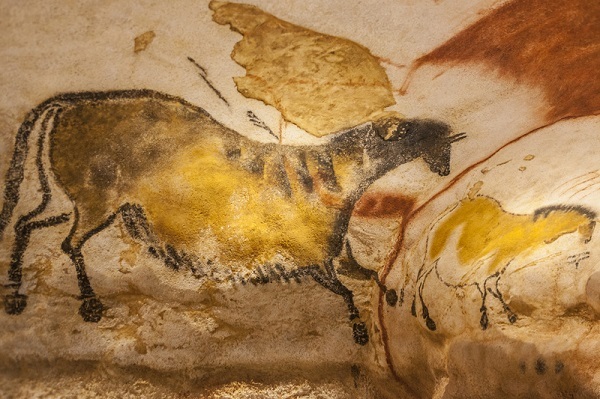

The Neolithic Era was a period of human history that lasted from around 10,000 BCE to 3,000 BCE. During this time, there were significant technological advancements and innovations that had a profound impact on human society.
These innovations also had a significant impact on the art of the time, leading to the creation of new forms of artistic expression and the development of unique characteristics in Neolithic art. Examples of this art can be found in Venus figurines, cave paintings, rock carvings, pottery, and megalithic structures like Stonehenge.

Megalithic Structure of Stonehenge
The development of agriculture and the domestication of animals led to the creation of permanent settlements, allowing for the development of more complex societies.
Pottery allowed for the creation of a wide range of objects, from simple utility vessels to highly decorated figurines.
Metal tools and weapons made the production of art more precise and efficient. Metalworking also allowed for the creation of new forms of art such as jewelry, belt buckles and other decorative items.
The creation of permanent settlements and the development of agriculture also led to the growth of trade, which allowed for the exchange of ideas and artistic styles between different cultures. This led to a greater diversity of art forms and styles.
The Neolithic Era saw the development of permanent settlements, as opposed to the nomadic lifestyle of the previous era. This change allowed for the growth of more complex societies and the development of new forms of social organisation.
Permanent settlements led to the growth of larger communities, which required new forms of governance, and social hierarchy.
This led to the development of specialised tasks and roles within society, such as farmers, artisans, and leaders. Specialisation allowed for the development of new technologies, skills and knowledge.
With the development of permanent settlements, people started to build houses, temples and other structures, which provided a new canvas for artistic expression. This led to the development of architecture as an art form, and the creation of monumental structures such as megaliths and tombs.
The Neolithic Era saw the development of agriculture, which allowed for the cultivation of crops and the domestication of animals. This development allowed for a more reliable food supply, and allowed for the growth of larger and more complex societies.
With the development of agriculture, people started to store food for future use, this led to the creation of granaries, and the use of pottery to store food and liquids.
This allowed for the growth of larger communities, as people no longer had to rely on hunting and gathering for their food.
Agriculture also led to the development of new tools and techniques for cultivating crops, such as irrigation systems and plows.
Neolithic art is characterised by the use of naturalistic forms, depicting everyday life and nature. This can be seen in the many figurines and sculptures that depict human and animal forms in a realistic manner.
The use of symbols and abstract shapes is also common in Neolithic art, often used to convey spiritual or religious beliefs. This can be seen in the use of geometric shapes and patterns in many artifacts, such as pottery and rock carvings.
The use of realistic forms, symbols and patterns in Neolithic art suggests that it was created to serve a religious or ceremonial function.
Some of the common motifs found in Neolithic art include animals, plants, and human figures, which depict the natural environment and everyday life. These motifs are repeated in many artifacts, indicating a strong tradition and cultural continuity.
Many Neolithic artworks also have a functional aspect, such as pottery, tools and weapons, which were used in daily life and had a symbolic meaning.
The Venus figurines, small statuettes of women that have been found in many Neolithic sites in Europe and Asia. These figurines have been interpreted as symbols of fertility and motherhood.
The cave paintings in Lascaux and Altamira, which are some of the earliest examples of figurative art. These paintings depict animals, human figures and abstract shapes.
The rock carvings in Valcamonica, which are some of the most extensive examples of rock art from the Neolithic era. These carvings depict animals, human figures.
The pottery found in Catalhoyuk, which is some of the most impressive examples of Neolithic pottery. These vessels were decorated with geometric shapes, animals and human figures.
The megalithic structures such as Stonehenge and Newgrange, which are some of the most impressive examples of Neolithic architecture.

Cave paintings in Lascaux
In conclusion, the Neolithic Era saw a significant shift in human society and culture, with advancements in technology, agriculture, and permanent settlements. These changes greatly influenced the art of the time, leading to new forms of expression and unique characteristics in Neolithic art. The legacy of this era can be seen in the variety of artifacts and structures that still exist today, providing a glimpse into the past and the artistic achievements of our ancestors. The Neolithic era's art is a testament to human creativity and resourcefulness, as well as the ability to adapt to a changing environment.
Q1. What is the Neolithic Era?
Ans. The Neolithic Era, also known as the New Stone Age, was a period of human history that lasted from around 10,000 BCE to 3,000 BCE. During this time, there were significant technological advancements and innovations that had a profound impact on human society.
Q2. What are the characteristics of Neolithic art?
Ans. Neolithic art is characterised by the use of naturalistic forms, depicting everyday life and nature, and the use of symbols and abstract shapes to convey spiritual or religious beliefs.
Q3. What are some examples of Neolithic art?
Ans. Some examples of Neolithic art include the Venus figurines, the cave paintings in Lascaux and Altamira, the rock carvings in Valcamonica, the pottery found in Catalhoyuk, and the megalithic structures such as Stonehenge and Newgrange.